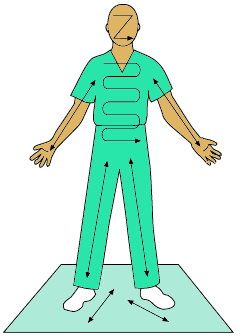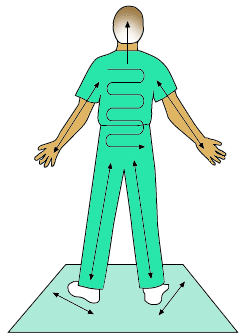How to Perform a Survey for Radiation Contamination



Instructions: Start at the head, continue systematically over the whole body, including the feet and soles. Repeat on other side of the body. Full survey can take many minutes.
- Brief instructions
- Inspect the equipment.
- Perform battery check.
- Conduct a source/operational check.
- Conduct a background reading.
- Conduct the survey
- See more detailed information:
- Radiation Detection and Survey Devices (REMM's new detailed review)
- External Radiation Contamination Tracking Forms
- Simple form to record external radiation contamination (PDF - 166 KB)
- Example of form to record results of external radiation contamination survey (PDF - 90 KB) (NY State Department of Health Community Reception Center)
- Radiological Survey Equipment and Dosimetry Devices (PDF - 829 KB) (DOE/TEPP): This excellent document reviews various kinds of radiation survey equipment and how to perform surveys.
- Population Monitoring and Radionuclide Decorporation Following a Radiological or Nuclear Incident (NCRP Report No. 166), Bethesda, MD, 2011. (See Chapter 6: Radiological Triage and Screening Guidance.)
- Geiger-Muller Radiation Detectors Job Aid (PDF - 430 KB) (HHS/CDC)
- Video demonstrations of various radiation survey meters (HHS/CDC)

- Photos of various survey meters and dosimeters
- To increase throughput speed of patients in a large mass casualty incident
- Decontamination can be conducted without radiological monitoring if ther s a lack of monitoring equipment.
- It may be necessary to perform only a "quick look" survey (head, face, shoulders, elbows, hands, thighs in areas where the hands would touch) as the most likely locations for contamination.
- The decision to use a "quick look" survey instead of the more time consuming full survey should be made by senior incident leaders in collaboration with specialists in radiation protection.
- It may be helpful to change probe speed, height of probe from the skin, and path width for various survey meters to increase throughput.
- See especially this reference below: FEMA REP-22 Background Information - Table 4, and pages 31-32 (PDF - 643 KB)
- If evacuees are being evaluated, consider dividing the population into 2 groups (FEMA REP-22 Background Information - page 33) (PDF - 643 KB).
- Group 1: those who have not bathed, changed clothes or been decontaminated since evacuating. This group could be surveyed using the faster detection parameters derived for loose-plus fixed contamination.
- Group 2: those who have bathed, changed clothes or been decontaminated. Group 2 could be monitored using detection parameters for fixed contamination
- This page reviews only techniques for detecting external contamination.
- Techniques for assessing and managing internal contamination are different.
- See NCRP Report 161: Volumes 1 and Volume 2 in Selected Reference list below for details.
- Dose assessment of inhaled radionuclides in emergency situations (Public Health England [PHE], formerly Health Protection Agency [HPA]/United Kingdom and Treatment Initiatives After Radiological Accidents (TIARA) project/European Commission, August 2007)
- See REMM information on Caveats about Radiation Countermeasures for Treatment of Internal Contamination
- See REMM information on: Target Levels for Decontamination of People
- Techniques for assessing and managing internal contamination are different.
References:
DOE
- How to Detect Radiation (Radiation Emergency Assistance Center/Training Site (REAC/TS))
- Personnel Monitoring (PDF - 817 KB) (REAC/TS)
- Radiological Survey Equipment and Dosimetry Devices (PDF - 829 KB) (DOE/TEPP): reviews various kinds of radiation survey equipment and how to perform surveys
- PrepTalks: Saving Lives After a Nuclear Detonation (YouTube - 23:10 min) (DOE/LLNL, DHS/FEMA)
HHS/CDC
- Population Monitoring in Radiation Emergencies: A Guide for State and Local Public Health Planners, April 2014.
- In the 2014 guide, see especially: Appendix D: Radiological Screening Criteria - External Contamination.
- This guidance updates the previous Draft Guidance from 2007.
- Guidance for Traveler Screening at Ports of Entry Following an International Radiological Incident (PDF - 1.69 MB) (CDC/NARR)
- Geiger-Muller Radiation Detectors Job Aid (PDF - 430 KB) (HHS/CDC)
FEMA
- Federal Emergency Management Agency, Contamination Monitoring Standard for a Portal Monitor Used for Radiological Emergency Response, FEMA-REP-21, (PDF - 62 KB) (FEMA, March 1995)
- Federal Emergency Management Agency, Contamination Monitoring Guidance for Portable Instruments Used for Radiological Emergency Response to Nuclear Power Plant Accidents, FEMA-REP-22, (PDF - 233 KB) (FEMA, October 2002)
NRC
- Minimal detectable concentrations with typical radiation survey instruments for various contaminants and field conditions. (PDF - 7.47 MB) (NUREG-1507, June 1998)
NCRP
- Decision Making for Late-Phase Recovery from Major Nuclear or Radiological Incidents, (NCRP Report No. 175), National Council on Radiation Protection and Measurements, Bethesda, MD, 2014.
- Population Monitoring and Radionuclide Decorporation Following a Radiological or Nuclear Incident, (NCRP Report No. 166), Bethesda, MD, 2011.
- Responding to a Radiological or Nuclear Terrorism Incident: A Guide for Decision Makers (PDF - 1.61 MB) (NCRP Report No. 165), Bethesda, MD, 2010.
- Management of Persons Contaminated with Radionuclides: Scientific and Technical Bases (NCRP Report No. 161, Vol. II), Bethesda, MD, 2010. Chapter 5: Performing Surveys and Controlling Personnel and Area Contamination.
- Management of Persons Contaminated With Radionuclides: Handbook (NCRP Report No. 161, Vol. I), Bethesda, MD, 2008.
- Key elements of preparing emergency responders for nuclear and radiological terrorism (NCRP Commentary No. 19), Bethesda, MD, December 2005. Purchase required.
EPA
- PAG Manual: Protective Action Guides and Planning Guidance for Radiological Incidents, EPA-400/R-17/001 (PDF - 1.48 MB) (EPA, January 2017)
CRCPD
- Handbook for responding to a radiological dispersal device first responder's guide - the first 12 hours (Conference of Radiation Control Program Directors, Inc., September 2006) (Decontamination Guidelines, pages 35-38)
IAEA
- Criteria for use in preparedness and response for a nuclear or radiological emergency, General Safety Guide, No. GSG-2, (PDF - 1.45 MB) (FAO, IAEA, ILO, PAHO, WHO, March 2011)
- Manual for First Responders to a Radiological Emergency (PDF - 2.2 MB) (CTIF, IAEA, PAHO, WHO, October 2006)
- Generic Procedures for Medical Response During a Nuclear or Radiological Emergency (PDF - 2,224 KB) (IAEA, WHO, July 2005)
Other Guidance
- Koenig KL, Goans RE, Hatchett RJ, Mettler FA Jr, Schumacher TA, Noji EK, Jarrett DG. Medical treatment of radiological casualties: current concepts. Ann Emerg Med. 2005 Jun;45(6):643-52 [PubMed Citation]

